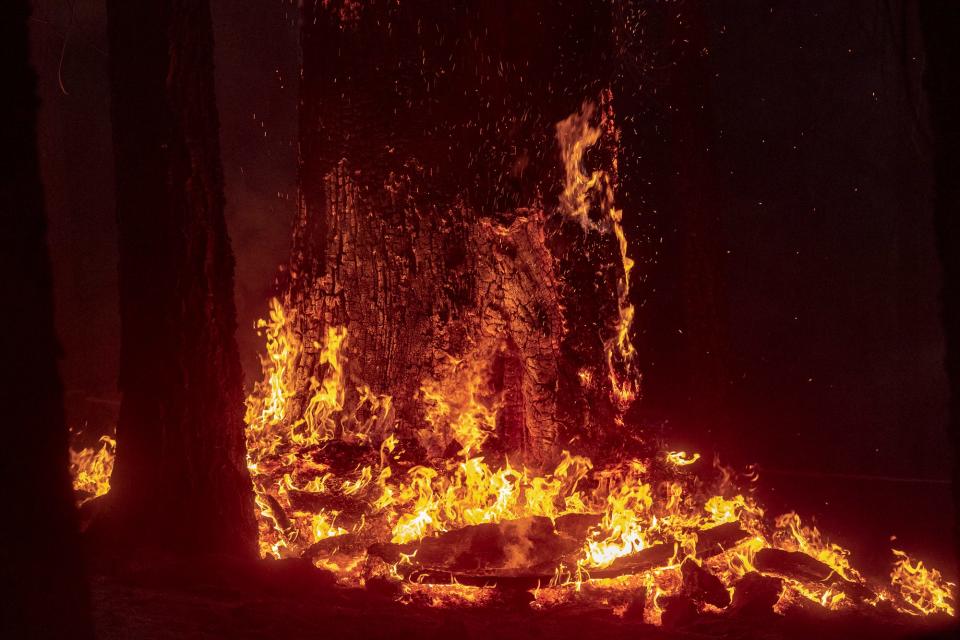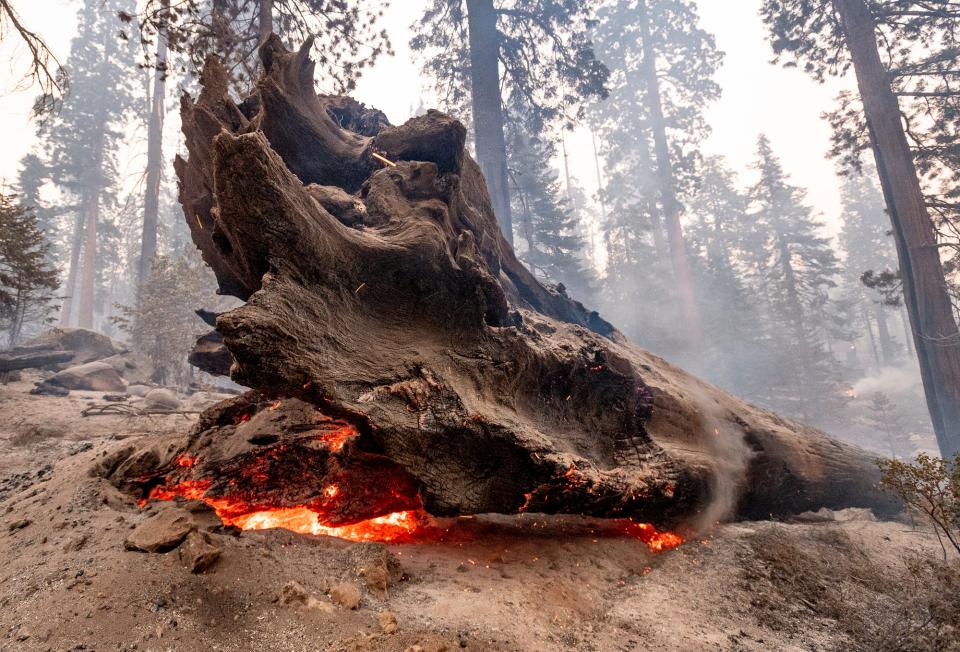California has lost 44 giant sequoias in Windy Fire. Now comes a 'Hail Mary' to save others.
The Windy Fire is tearing through California's famed sequoia country, with early surveys showing that the wildfire has killed 44 of the long-lived monarchs.
Now, a "Hail Mary" effort is underway to save the towering trees from a wildfire that has burned more than 150 square miles in the Sequoia National Forest, racing through nearly a dozen groves, including the world-famous Trail of 100 Giants.
Crews are scaling the 200-foot-tall giants and spraying the flaming crowns of nearby trees with water, wrapping their massive trunks in fire-resistant wrap and dropping high-tech gel from above. That's in addition to more traditional techniques such as laying sprinklers and clearing the groves of duff and other heavy fuels.
Despite those extraordinary efforts, the team has only been able to save a handful of trees in the hardest-hit groves, some of which haven't experienced fire in more than a century. While sequoias need fire to reproduce and thrive, high-intensity blazes can spread to their crowns and incinerate them.

"Five years ago, we weren't doing this because we didn't need to. There's no playbook for saving giant sequoia from these massive, high-intensity fires," said Garrett Dickman, a botanist with Yosemite National Park. "Not to diminish the heroism of the firefighters, but it's only a couple of individual trees that we're saving when we need to be thinking of the whole population."
The best way to do that, Dickman said, is through active forest management and prescribed fire – highly controlled burns carried out and overseen by professionals. In actively managed groves, the destruction caused by Windy Fire has been minimal, he said.
In Sequoia National Park to the north, firefighters have credited decades of prescribed burning for saving the Giant Forest Grove and General Sherman, the world's largest tree by volume, from the KNP Complex. Lightning caused both the KNP and Windy fires to ignite on Sept. 9.
Keep the climate on your mind: Subscribe to the weekly Climate Point newsletter from expert reporter Janet Wilson
"We thought we had more time to make these Hail Mary measures, but (the Windy Fire) is moving so fast and burning so hot," he said.
Though it's October, Windy Fire incident commander Mark Morales said "conditions in the forest are more like what you would observe in August: Very dry with high temperatures and low humidity."
Now, firefighters are doing damage control, going into the burned groves and raking the burning duff off the sequoias' sensitive roots, which grow close to the ground. At the same time, Dickman is keeping a "body count" of the likely dead sequoia: Those that have toppled over completely or had more than 95% of their crowns burned.

It's been a harrowing decade for the world's giant sequoia population. The 2020 Castle Fire, which burned in the same area as the Windy Fire, killed between 10% and 14% of the world's sequoias – up to 10,600 trees.
Before 2015, there have only been two recorded instances of mass sequoia die-offs. The trees have extremely thick bark and crowns that tower hundreds of feet above the forest floor, making them one of the world's most fire-adapted species.
But even the regal sequoias are having trouble withstanding the West's record mega-blazes. Forests across the Sierra Nevada are overgrown with trees, millions of them dead and desiccated due to a climate-change-driven drought now strangling the Golden State.
In Dickman's Yosemite, for example, some parts of the forest contain 125 tons of dead wood per acre. That's roughly the equivalent of a Boeing 747 in lumber, he said.
"This is a fire-resistant species. If anything can take the punch, it's giant sequoias. But this punch is way too big and it's hitting way too hard," Dickman said. "Sequoias wouldn't be on the landscape if fires were like (the Windy Fire) in the past. You couldn't have 2,000- or 3,000-year-old trees. It just isn't possible."
He added, "Giant sequoias are one of those things that represents a place and a people; they help make California California. You look up at those trees, and you see America. They're big, their scars are beautiful, and they live a really long time."
The Windy Fire was 68% contained as of Monday morning, according to fire officials.
Joshua Yeager covers water, agriculture, parks, and housing for the Visalia Times-Delta and Tulare Advance-Register newspapers. Follow him on Twitter @VTD_Joshy.
This article originally appeared on Visalia Times-Delta: Windy Fire has killed 44 of California's famed giant sequoias – so far

